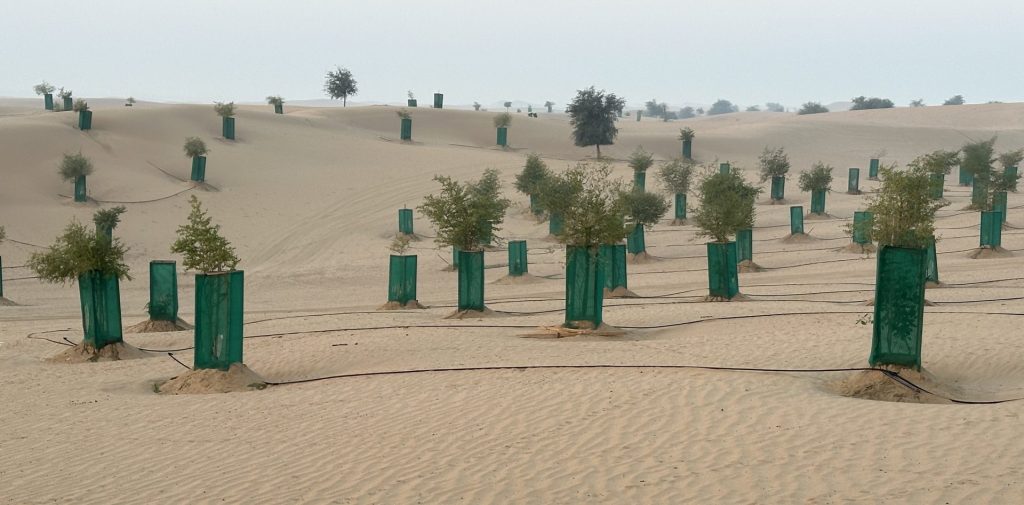What Do You Know About The UAE’s Ghaf Tree?

The Emblem of Resilience in the UAE
The United Arab Emirates (UAE) is a land of contrasts, where modernity seamlessly blends with tradition and vast expanses of desert are dotted with life-sustaining oases. Amidst this arid landscape stands a symbol of resilience and adaptation: the Ghaf tree (scientific name: Prosopis cineraria).
The Ghaf—the national tree of the UAE—has been revered for centuries by the region’s Indigenous peoples. It is unique in Emirati culture, ecology, and sustainability efforts.
In the heart of Emirati culture, the Ghaf tree is more than just a botanical specimen; it is a symbol of fortitude and endurance. Its deep roots anchor it firmly into the sandy soils of the desert, embodying the Emirati spirit of perseverance in the face of adversity.

Throughout history, the Ghaf tree, as it is widely known in the UAE, has been revered for its ability to thrive in harsh conditions, providing shade, sustenance, and shelter to humans and wildlife alike.
The Ghaf tree is deeply entrenched in Emirati folklore and traditions. It features prominently in poetry, art, and local customs, serving as a reminder of the inseparable bond between the land and its people.
Its resilient nature and ability to survive in the harshest desert environments have symbolised hope and resilience for generations of Emiratis.
Long Life
On average, drought-tolerant Ghaf trees can thrive for up to 120 years. An iconic instance of their longevity is the ‘Tree of Life’ in Bahrain, which is approximately 400 years old.
This ancient tree continues to flourish in the arid desert landscape despite the absence of evident water sources. Its roots can penetrate the ground up to 30 metres in search of water, sometimes surfacing several metres away from the main tree trunk.
In a region where water is scarce, and temperatures soar to extreme levels, the Ghaf tree plays a crucial role in maintaining ecological balance. Its extensive root system helps stabilise the desert soil, preventing erosion and desertification.
Moreover, the Ghaf tree is a pioneer species, capable of colonising barren desert landscapes and creating microhabitats that support diverse flora and fauna. This remarkable adaptability of the Ghaf tree is a source of inspiration, showing the power of nature to thrive even in the harshest environments.
It occurs in Western Asia, the Arabian Peninsula and the Indian Subcontinent. The Ghaf tree’s ability to thrive in low-water conditions is vital to desert ecosystems. Its deep taproots enable it to access groundwater reserves, providing a reliable source of moisture for itself and neighbouring plants.
Natural Habitat
Additionally, the Ghaf tree is a natural habitat and food source for various desert-adapted species, including birds, insects, and mammals.
Recognising the ecological importance of the Ghaf tree, the UAE government has implemented various initiatives to conserve and protect this iconic species.

One such initiative is the Ghaf Tree Conservation Programme, which aims to increase awareness about its ecological significance and promote its conservation through tree planting campaigns and habitat restoration efforts.
Furthermore, the UAE’s leadership in sustainable development has led to the incorporation of Ghaf tree conservation into broader environmental policies and strategies.
As per UAE Federal Law No. 24 of 1999, the cutting, uprooting, or illegally collecting wild plants is prohibited. Stringent measures are enforced, especially concerning the protection of Ghaf trees, due to their significant impact on native biodiversity.
Plant Nursery
The Environment Agency – Abu Dhabi (EAD) operates a plant nursery housing the seeds of 58 species of native wild plants, including the Ghaf tree.
In 2019, an initiative involved planting 600 Ghaf trees in the Al Faya Region in the UAE. These trees provided shelter and habitat for thousands of native desert species, including globally endangered ones, and acted as a natural barrier against the area’s prevailing winds.

Additionally, the Ghaf tree was selected as the symbol for the Year of Tolerance in 2019, underscoring its historical and cultural significance as a symbol of stability and peace in the UAE’s desert landscape.
Facing Challenges
Despite its cultural and ecological significance, the Ghaf tree faces numerous challenges, including habitat loss, overgrazing, and urbanisation.
Climate change poses an additional threat, as rising temperatures and changing precipitation patterns could alter desert ecosystems, impacting the Ghaf tree’s ability to survive and reproduce.

However, there is hope on the horizon. Through concerted conservation efforts and community engagement, stakeholders in the UAE are working together to safeguard the future of the Ghaf tree.

By raising awareness, implementing sustainable land management practices, and restoring degraded habitats, the UAE strives to ensure the continued thriving of this iconic species for generations.
Featured image: A Ghaf tree grove occurs naturally in desert dunes in Ras Al Khaimah emirate in the UAE. Arnold Pinto













